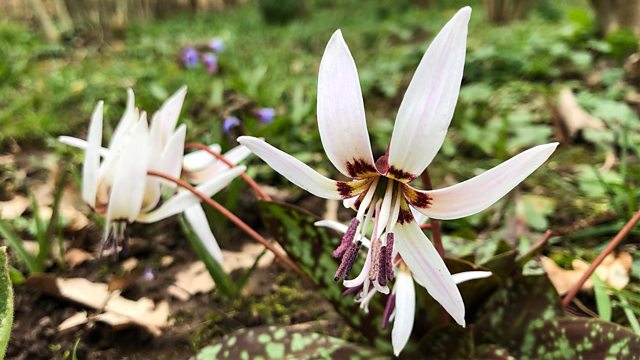
Episode 5
Monty gets to grips with a new project, Adam Frost meets a man who is passionate about growing unusual and exotic plants from seed, and Carol Klein profiles the camellia.
There is a full hour of gardening from Longmeadow this week and Monty gets to grips with a new project, beefs up his borders by dividing perennials and celebrates spring flowering shrubs.
Frances Tophill is growing vegetables this year on an allotment and this week she begins to prepare her plot. If your shed is chock full of out-of-date seeds, old compost, dirty pots and rusty tools, Nick Bailey has lots of hints and tips on how to get everything shipshape for the season ahead. Adam Frost explores a tropical garden in Dorset and meets a man who is passionate about growing unusual and exotic plants from seed, we travel to Suffolk to meet a woman who collects and grows a wide range of bellflowers, and Carol Klein profiles the best of the season's flowers - this week it is the camellia.
Last on
Clips
-
![]()
Lawnmower maintenance
Duration: 03:21
-
![]()
Starting an allotment
Duration: 06:23
-
![]()
Camellia cuttings
Duration: 02:39
Plants for tropical gardens

Tropical gardens are becoming increasingly popular in Britain. Their exotic, relaxing mood makes you feel like being on holiday, without leaving home. What sets tropical gardens apart is their distinctive mood. They are often lush and soothing with plants that are impactful and contemporary.
Tropical plants are hardier than you might think, and many will survive surprisingly cold temperatures. Many of the plants used may struggle with drought, so keep them well-watered, especially in their first year.
The trick to getting tropical plants to work in your garden is to mix them with British plants. Create a framework of exotic varieties and fill in with garden stalwarts like carex, sedge, hosta, astrantia, miscanthus and Japanese anemone.
Plant tropical varieties in spring, so their roots have time to get established before winter.
Mike Clifford’s garden is open for the National Garden Scheme
(www.ngs.org.uk)
Tropical plants top 10
Canna All cannas are good and in mild areas, you might get away with leaving the rhizomes in the ground over winter if you apply a thick mulch in autumn. In more northern climes, it is probably safer to lift and store them under cover.
Chamaerops humilis (Dwarf fan palm) A great evergreen palm, perfect where space is limited as it is quite slow growing. Hardy throughout most of the UK.
Dicksonia antarctica (Soft tree fern) With large, dramatic fronds tree ferns provide the perfect contrast for other large-leaved plants. They are slow growing, so buy the biggest plant you can afford! Remember to protect the crown with fleece throughout winter.
Fatsia japonica (Japanese aralia) A popular houseplant in the 70s, this evergreen shrub with huge shiny leaves really comes into its own in the garden. It is surprsingly hardy and is another good subject for shade.
Hedychium aurantiacum (Ginger lily) A truly tropical-looking orange flower, it's a bulb-like plant and will push up through the soil in early summer to produce red flowers late in the season.
Hosta A very flexible plant that is ideal for partial or full shade. It gives great ground cover and comes in a huge range of leaf variations. Larger varieties truly give that jungle feel and are often less susceptible to the dreaded slugs and snails. Must be kept well-watered.
Musa basjoo (Japanese banana) A tropical paradise just wouldn’t be complete without a banana, and this species is a good one to start with. In a mild winter, it will survive perfectly well outdoors and in Steve’s experience, will grow back from the base if the winter takes its toll.
Phyllostachys nigra (Black bamboo) Bamboos are the perfect plant for a tropical look. They are reliably hardy and evergreen, but go for a clump-forming type like the black bamboo, Phyllostachys nigra, as some can be very invasive.
Tetrapanax papyrifer ‘Rex’ (Chinese rice-paper plant) A fabulous plant for a sheltered part of the garden with huge palmate leaves. A real talking point. Has a tendency to throw up suckers once established, but these are easily removed.
Zantedeschia aethiopica (Arum lily) This striking plant has stunning white flowers and glossy green foliage. It’s fairly hardy and likes full sun or partial shade. Mulch in autumn when it starts to fade.
Sue Wooster's Campanulas

Sue Wooster is the national Collection Holder of alpine campanulas and is also a RHS Gold Medallist.
Most of Sue’s plants are sourced from specialist alpine nurseries, and from enthusiasts across Europe and the UK. She belongs to the Alpine Garden Society, the Scottish Rock Garden Club and North American Rock Garden Society. Many alpine campanulas are grown from seed, and clubs and societies are a great way of finding good sources of more unusual wild collected varieties.
Several forms of campanulas have edible parts. Campanula versicolor is the only bellflower with a scent – on a hot day the plant smells of cloves. The leaves can be used in salads, as can Campanula poscharskyana. Campanula rapunculus has been grown since the middle ages in the vegetable garden for its edible, parsnip-like roots.
Bellflower Nursery
The Walled Garden
Langham Hall
Langham
Bury St Edmunds
Suffolk IP31 3EE
Credits
| Role | Contributor |
|---|---|
| Presenter | Monty Don |
| Presenter | Nick Bailey |
| Presenter | Adam Frost |
| Presenter | Carol Klein |
| Presenter | Frances Tophill |
| Production Manager | Michael Rogers |
| Series Producer | Sharon Fisher |
| Executive Producer | Paolo Proto |



